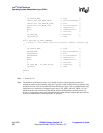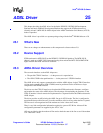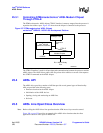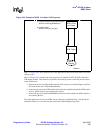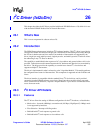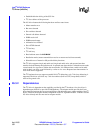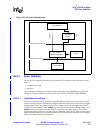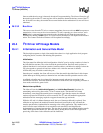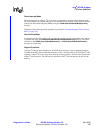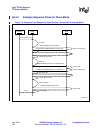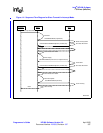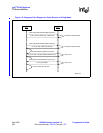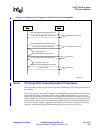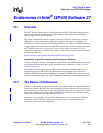
Intel
®
IXP400 Software
I
2
C Driver (IxI2cDrv)
April 2005 IXP400 Software Version 2.0 Programmer’s Guide
334 Document Number: 252539, Revision: 007
Once an arbitration loss error is detected, the unit will stop transmitting. The client will need to call
the transfer again and the I
2
C status register will be checked to determine the busy status of the I
2
C
bus. If the bus is not busy, the transfer that occurred before the bus arbitration loss error will be re-
submitted.
26.3.3.2 Bus Error
This error occurs when the I
2
C unit, as a master transmitter, does not receive an ACK in response to
transmission. A bus error can also occur when the I
2
C unit is operating as a slave receiver, and a
NACK pulse is generated. In master transmit mode, the hardware will abort the transaction by
automatically sending a
STOP signal. As a slave receiver, the behavior will depend on the master’s
action. The counters for both occurrences will be updated accordingly.
26.4 I
2
C Driver API Usage Models
26.4.1 Initialization and General Data Model
This description assumes a single client model where there is a single application-level program
configuring the I
2
C interface and initiating I/O operations.
Initialization
The client must first define the initial configuration of the I
2
C port by storing a number of values in
the IxI2cInitVars structure. The values include the speed selection, data flow mode, pointers to
callback functions for various data scenarios, hardware address, and behavior settings for how the
I2C unit responds to general call and slave address calls. After the structure is defined,
ixI2cDrvInit() may be called to enable the port.
Once the port is enabled, the client will use one of the data models described later in this chapter
(either Interrupt or Polling mode) to determine how and when data I/O operations need to occur.
A callback or handler may be registered for interrupt transmit and receive operations in the
IxI2cInitVars structure. There are different callbacks for when the I
2
C unit is operating in master or
slave mode, and also for general calls.
Master-Interrupt Mode
The client will use the
ixI2cDrvWriteTransfer() and ixI2cDrvReadTransfer() functions for
transmitting and receiving data on the I
2
C bus in master mode. The functions will return
immediately, even though the transfer has not completed. Upon function return, the callback
routines registered in IxI2cInitVars will be executed. The I
2
C unit will handle the appropriate
arbitration and bus messaging required to support the transfer type and mode.
While the I
2
C unit is in Master-Interrupt mode, the use of interrupt callbacks is optional. If no
callbacks are registered, the read/write transfer functions discussed above will wait until the
transfer operation has completed before returning to the calling application. This method can be
used if transfer status information is not needed for each transaction and simplifies the
implementation of repeated start transfers. The data that is passed in the callback includes transfer
mode, buffer pointer and buffer size. Since this data is already known to the client application,
processing of this data via the callback would be inefficient.



